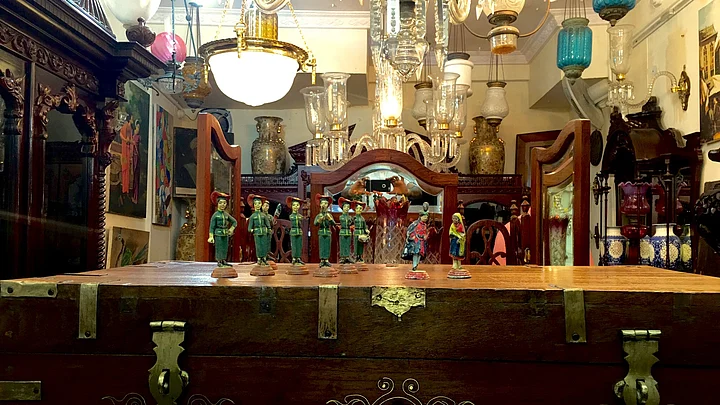Hyderabad, geologically, is one of the oldest places on the planet, with rock formations over 2,500 million years old. But I was more curious about its recent past. And this is what I gathered, from a curio store.
The last Nizam of Hyderabad. He was also the most loved. He is also the richest Indian ever. One of his paperweights was a diamond worth $50 million. In September 1948, the Indian Armed Forces annexed the State of Hyderabad into the Indian Union, in a five day coup termed Operation Polo.
Osman Ali Khan died at the ripe age of 80, ending the Asaf Jahi dynasty, that began with Qamar-ud-Din Siddiqui in 1721. It also ended three hundred years of unbelievable opulence, cultural fomentation and unique artistic expression.
These are adapted from the blue glaze pottery technique, which arrived in Rajasthan in the 17th century from the Mughal courts of Delhi. In less than a century, the technique travelled down to Hyderabad. It was first developed by Mongol artisans, who combined Chinese (pottery) and Persian (decoration) techniques.
Recent designs are completely spherical and devoid of the ridges, which I think add to the beauty and are rather more practical. Don’t you?
“There is much that is common between Iranian and Hyderabadi cultures.” — Yazidi, tea stall owner.
Obsession, misery and massacre. That about sums up the history of the Zoroastrans of Iran.
In 1796, at the beginning of the Qajar dynasty, the Zoroastran population in the cities of Yazd and Kerman was around fifty thousand. Just fifty years later, Count De Gobineu, French ambassador to Iran writes, “Only 7,000 of them remain. Only a miracle may save them from extinction.”
Like their ancestors who migrated to India eight centuries before them, many of the Zoroastrans followed suit. Hyderabad (and the world) owes them Irani Chai, poetry and the singularly beautiful inlay work at the Badshahi Ashoorkhana (that’s another story).
This is a Baluster style chandelier. Baluster or Balustre (Italian) refers to Balaustra, the pomegranate flower. It was part of the Falaknuma palace, which Osman Ali Khan’s father fell in love with and bought.
The last guest to the palace was President Rajendra Prasad, who came there in the 1950s. It then fell silent and reopened as a Taj Hotel in the year 2000.
Kondapalli is a little village four hours away from Hyderabad. For four hundred years, artisans have carved soft wood and painted exquisite figurines for the ‘Golu’ in Navarathra celebrations. Today it’s a flourishing craft industry.
The legs and torso are carved from a single piece of ‘Punki’ wood. To join the legs and arms, sawdust mixed with cooked tamarind seed powder (to form a paste called ‘makh’) is used.
It is painted with powder paint mixed in the resin of the velvet mesquite tree. Traditionally, men carve, women paint.
Abdul has been running the store for over three decades now. His family are the caretakers of the Badshahi Ashoorkhana, a heritage site for over four centuries. He drives a very hard bargain, but he’s a beautiful man to know.
